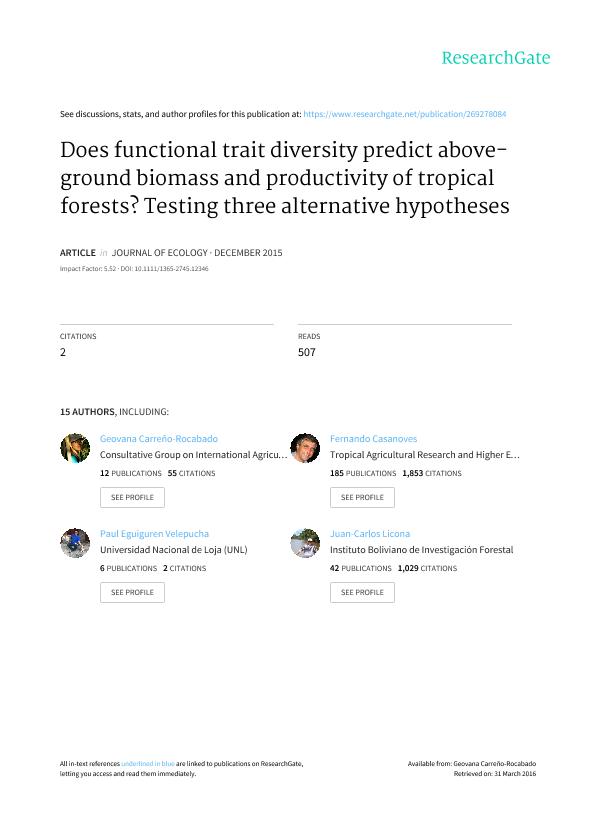Mostrar el registro sencillo del ítem
dc.contributor.author
Finegan, B.
dc.contributor.author
Peña Claros, Marielos

dc.contributor.author
de Oliveira, Alexandre

dc.contributor.author
Ascarrunz, Nataly

dc.contributor.author
Bret Harte, M. Syndonia

dc.contributor.author
Carreno Rocabado, Geovana

dc.contributor.author
Casanoves, Fernando

dc.contributor.author
Diaz, Sandra Myrna

dc.contributor.author
Eguiguren Velepucha, Paul

dc.contributor.author
Fernandez, Fernando
dc.contributor.author
Licona, Juan Carlos

dc.contributor.author
Lorenzo, Leda

dc.contributor.author
Salgado Negret, Beatriz

dc.contributor.author
Vaz, Marcel

dc.contributor.author
Poorter, Lourens

dc.date.available
2017-06-09T15:39:03Z
dc.date.issued
2015-01
dc.identifier.citation
Finegan, B.; Peña Claros, Marielos; de Oliveira, Alexandre; Ascarrunz, Nataly; Bret Harte, M. Syndonia; et al.; Does functional trait diversity predict aboveground biomass and productivity of tropical forests? Testing three alternative hypotheses; Wiley Blackwell Publishing, Inc; Journal Of Ecology; 103; 1; 1-2015; 191-201
dc.identifier.issn
0022-0477
dc.identifier.issn
1365-2745
dc.identifier.uri
http://hdl.handle.net/11336/17873
dc.description.abstract
Tropical forests are globally important, but it is not clear whether biodiversity enhances carbon storage and sequestration in them. We tested this relationship focusing on components of functional trait biodiversity as predictors. Data are presented for three rain forests in Bolivia, Brazil and Costa Rica. Initial above-ground biomass and biomass increments of survivors, recruits and survivors + recruits (total) were estimated for trees ≥10 cm d.b.h. in 62 and 21 1.0-ha plots, respectively. We determined relationships of biomass increments to initial standing biomass (AGBi), biomass-weighted community mean values (CWM) of eight functional traits and four functional trait variety indices (functional richness, functional evenness, functional diversity and functional dispersion). The forest continuum sampled ranged from ‘slow’ stands dominated by trees with tough tissues and high AGBi, to ‘fast’ stands dominated by trees with soft, nutrient-rich leaves, lighter woods and lower AGBi. We tested whether AGBi and biomass increments were related to the CWM trait values of the dominant species in the system (the biomass ratio hypothesis), to the variety of functional trait values (the niche complementarity hypothesis), or in the case of biomass increments, simply to initial standing biomass (the green soup hypothesis). CWMs were reasonable bivariate predictors of AGBi and biomass increments, with CWM specific leaf area SLA, CWM leaf nitrogen content, CWM force to tear the leaf, CWM maximum adult height Hmax and CWM wood specific gravity the most important. AGBi was also a reasonable predictor of the three measures of biomass increment. In best-fit multiple regression models, CWMHmax was the most important predictor of initial standing biomass AGBi. Only leaf traits were selected in the best models for biomass increment; CWM SLA was the most important predictor, with the expected positive relationship. There were no relationships of functional variety indices to biomass increments, and AGBi was the only predictor for biomass increments from recruits. Synthesis. We found no support for the niche complementarity hypothesis and support for the green soup hypothesis only for biomass increments of recruits. We have strong support for the biomass ratio hypothesis. CWMHmax is a strong driver of ecosystem biomass and carbon storage and CWM SLA, and other CWM leaf traits are especially important for biomass increments and carbon sequestration.
dc.format
application/pdf
dc.language.iso
eng
dc.publisher
Wiley Blackwell Publishing, Inc

dc.rights
info:eu-repo/semantics/openAccess
dc.rights.uri
https://creativecommons.org/licenses/by-nc-sa/2.5/ar/
dc.subject
Biodiversity
dc.subject
Biomass Ratio
dc.subject
Ecosystem Precesses
dc.subject
Green Soup Hypothesis
dc.subject
Niche Complementarity
dc.subject
Plant Population And Community Dynamics
dc.subject.classification
Ecología

dc.subject.classification
Ciencias Biológicas

dc.subject.classification
CIENCIAS NATURALES Y EXACTAS

dc.title
Does functional trait diversity predict aboveground biomass and productivity of tropical forests? Testing three alternative hypotheses
dc.type
info:eu-repo/semantics/article
dc.type
info:ar-repo/semantics/artículo
dc.type
info:eu-repo/semantics/publishedVersion
dc.date.updated
2017-05-08T15:33:16Z
dc.journal.volume
103
dc.journal.number
1
dc.journal.pagination
191-201
dc.journal.pais
Reino Unido

dc.journal.ciudad
Londres
dc.description.fil
Fil: Finegan, B.. Production and Conservation in Forests Programme; Costa Rica
dc.description.fil
Fil: Peña Claros, Marielos. Facultad de Ciencias Agrícolas. Instituto Boliviano de Investigación Forestal; Bolivia. Wageningen University. Forest Ecology and Forest Management Group; Países Bajos
dc.description.fil
Fil: de Oliveira, Alexandre. Universidade de São Paulo. Departamento de Ecologia; Brasil
dc.description.fil
Fil: Ascarrunz, Nataly. Facultad de Ciencias Agrícolas. Instituto Boliviano de Investigación Forestal; Bolivia
dc.description.fil
Fil: Bret Harte, M. Syndonia. University of Alaska. Institute of Arctic Biology; Estados Unidos
dc.description.fil
Fil: Carreno Rocabado, Geovana. Facultad de Ciencias Agrícolas. Instituto Boliviano de Investigación Forestal; Bolivia. Wageningen University. Forest Ecology and Forest Management Group; Países Bajos
dc.description.fil
Fil: Casanoves, Fernando. Biostatistics Unit; Costa Rica
dc.description.fil
Fil: Diaz, Sandra Myrna. Consejo Nacional de Investigaciones Científicas y Técnicas. Centro Científico Tecnológico Conicet - Córdoba. Instituto Multidisciplinario de Biología Vegetal. Universidad Nacional de Córdoba. Facultad de Ciencias Exactas Físicas y Naturales. Instituto Multidisciplinario de Biología Vegetal; Argentina
dc.description.fil
Fil: Eguiguren Velepucha, Paul. Production and Conservation in Forests Programme; Costa Rica
dc.description.fil
Fil: Fernandez, Fernando. Production and Conservation in Forests Programme; Costa Rica
dc.description.fil
Fil: Licona, Juan Carlos. Facultad de Ciencias Agrícolas. Instituto Boliviano de Investigación Forestal; Bolivia
dc.description.fil
Fil: Lorenzo, Leda. Universidade de São Paulo. Departamento de Ecologia; Brasil
dc.description.fil
Fil: Salgado Negret, Beatriz. Production and Conservation in Forests Programme; Costa Rica. Instituto Alexander von Humboldt; Colombia
dc.description.fil
Fil: Vaz, Marcel. Universidade de São Paulo. Departamento de Ecologia; Brasil
dc.description.fil
Fil: Poorter, Lourens. Facultad de Ciencias Agrícolas. Instituto Boliviano de Investigación Forestal; Bolivia. Wageningen University. Forest Ecology and Forest Management Group; Países Bajos
dc.journal.title
Journal Of Ecology

dc.relation.alternativeid
info:eu-repo/semantics/altIdentifier/url/http://onlinelibrary.wiley.com/doi/10.1111/1365-2745.12346/abstract
dc.relation.alternativeid
info:eu-repo/semantics/altIdentifier/doi/http://dx.doi.org/10.1111/1365-2745.12346
Archivos asociados
